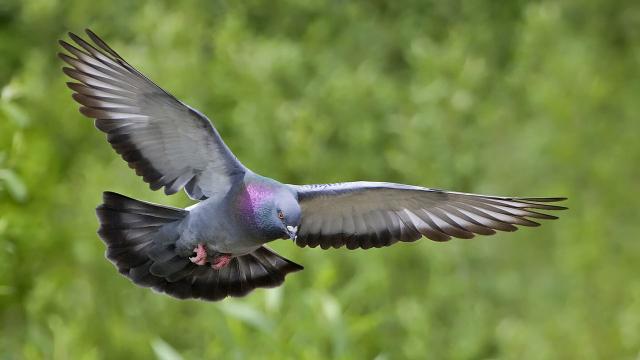Birds probably know quantum physics better than many humans – it just comes to them innately.
A rock dove studying quantum mecahnics, sort of. Photo: Alan D. Wilson (Wikimedia Commons)
To help them navigate long distances across the globe, birds are thought to have proteins in their eyes that could perhaps let them literally see the Earth’s magnetic field, a bit like a natural heads-up display. Two teams of scientists now think they have identified the light-sensitive protein key to this process, which relies on an innate attribute of electrons called “spin”, one of the most quantum mechanical properties there is.
How would such a protein work? You might remember that atoms consist of a nucleus orbited by electrons. Each of these electrons has a spin, which can either be “up” or “down”. The spin essentially makes each electron a tiny bar magnet.
Dan Garisto at ScienceNews reports:
Two new studies – one examining zebra finches published March 28 in Journal of the Royal Society Interface, the other looking at European robins published January 22 in Current Biology – both single out Cry4, a light-sensitive protein found in the retina. If the researchers are correct, this would be the first time a specific molecule responsible for the detection of magnetic fields has been identified in animals.
As described in a paper in the Annual Review of Biophysics, some molecules have an odd number of electrons, leaving some unpaired, making those electrons sensitive to external magnetic fields. You can produce two of these “radical” molecules at the same time – perhaps one molecule gives an electron to another, or a molecule breaks in two such that each piece has an unpaired electron. The two pieces now have one each in a pair of correlated electrons, forming one of two states based on their spins: Pointing the same way or pointing opposite ways.
With the help of hydrogen and nitrogen nuclei, which also have spins, the electrons oscillate between the two states in an external magnetic field. This process may even be sensitive to Earth’s very weak magnetic field. The direction of the molecules compared to the magnetic field could change the nature of that oscillation.
If you have a pair of these radicals in a chemical reaction that was sensitive to this oscillation, the Earth’s magnetic field could potentially change the reaction’s outcome. If the bird is facing one way, the radicals combine into a single final product. If the bird is facing another way, the radicals stay separated. If such a reaction happened in the birds’ eyes, perhaps they could literally see the Earth’s magnetic field.
Now, one team of researchers studied several possible light-sensitive proteins in finches and found that one of the proteins, Cry4, was constantly produced during the day, unlike others which varied throughout the day. The team studying robins found that Cry4 was found in the birds’ eye, and the birds made more of it during their migration season.
This isn’t definitive proof of discovery, one of the study’s authors, Henrik Mouritsen at the Institute of Biology and Environmental Sciences in Germany, told Garisto. Maybe next they will study birds without Cry4.
So, birds aren’t studying quantum mechanics in the same way that scientists study birds. But they might require an innate understanding of spin, one of the most quantum mechanical things that exists, just to get around.
[Journal of the Royal Society Interface , Current Biology and Annual Review of Biophysics via ScienceNews, h/t Dan Garisto!]
